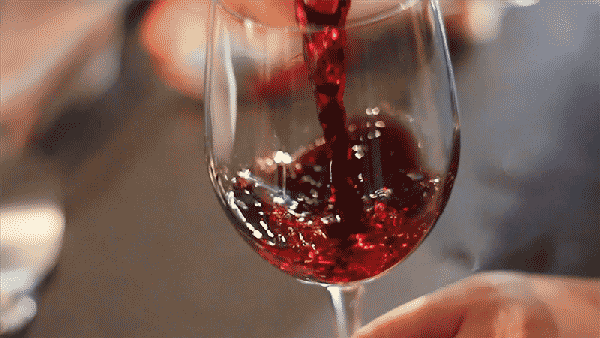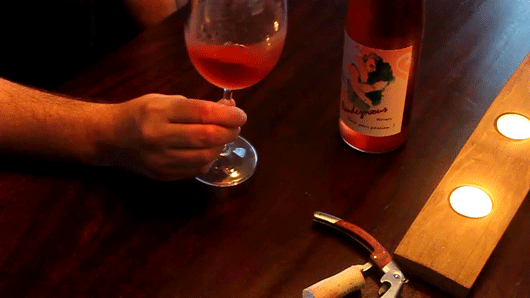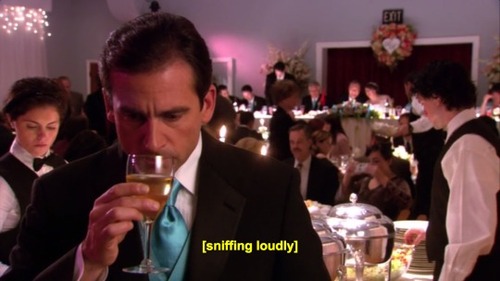As a college student, finding a tasty bottle of inexpensive wine is a common problem. Is the $20 bottle worth it? This label looks cool, that probably means it tastes good, right?
The options in the wine aisle of the grocery store can be overwhelming and often yield mixed results. However, with some quick knowledge, you can move away from that bottom shelf two-buck Chuck and discover what your palate has been missing out on all these years.
Having worked at a local winery, I’ve learned a lot about how to enjoy wine. I can’t tell you how many times I’ve heard people say, “I just don’t like dry wine” or “I have no idea what I’m even looking for.” While those sweet wines are a tasty treat (and great for cocktail mixers that up the ABV), there’s so much more out there to try. Let’s start with the basics of tasting.

GIF courtesy of giphy.com
The “5 S’s” are used by professional wine tasters all over the world, and they are a great place to start. To begin, pour yourself about an inch of wine (you can pour a full glass once you know you like it). Now let your senses lead the way.
1. See

GIF courtesy of giphy.com
What does the wine look like? Is it red? White? Is it clear, or does it have a yellow tint to it? Is it a true red, or does it have hints of maroon or purple? None of these things necessarily correlate to taste, but color can serve as an introduction to what you’re about to experience.
2. Swirl

GIF courtesy of giphy.com
Now it’s time to get your wine snob on. As annoying as it may look, the swirl is key to opening up the aromas and flavors of your wine. Start by keeping your wine glass on the table with your hand at the base. To make sure you don’t spill, it’s important that you do not fill the glass up all the way. Make slow wide circles with the glass and let the rich smell of wine fill your kitchen.
3. Smell

Photo courtesy of tumblr.com
Once you’ve swirled, your wine is ready to be smelled. Before taking in the aroma, get your nose as deep into the wine glass as possible (wine tasting is not for those worried about looking stupid). Then, take in a slow, deep breath and really think about what you’re experiencing.
Is your red wine spicy, like black pepper, or is it more fruity? (Common red wine fruit descriptors are usually cherry, date, or plum.) White wines more commonly have lighter fruit notes. Does it smell tropical, like pineapple or mango? Or is it grapey, with hints of pear and apple? A few white wines, such as chardonnay, have a buttery characteristic that smells like popcorn.
If it’s neither of these, try describing it as herbaceous; wines like sauvignon blanc can give off lemongrass or rosemary characteristics. Feel free to give it a second swirl and try again if you’re having trouble describing what you smell.
4. Sip

GIF courtesy of giphy.com
After all this anticipation, the wine can finally reach your lips, but resist the urge to gulp it down. Let this part happen as slowly as possible. Only take in enough wine to coat your tongue and let it sit there. You don’t need to go full-on sommelier and rinse it around like mouthwash (that’s a little too Ke$ha for our purposes). Just let the wine fill your palate, touching every taste bud on your tongue.
Just like you did with the smell, think about what you’re experiencing. You’ll probably notice that what you’re tasting is often very similar to what you smelled (hence the importance of the third S), but sometimes the smell can be deceiving. What smelled fruity and sweet earlier could present itself with herbaceous qualities on the tongue. Don’t be afraid to contradict yourself; wine is full of contradictions.
It’s important with wine tasting to let your own palate be your guide. In your life, you’ve had at least 21 years of experience with taste (no one tastes wine underage, right?). Does this wine remind of of any other flavors you’re familiar with? Can you picture biting into a fresh, juicy, bittersweet summer cherry? Can you recall the raisiny sweetness of a medjool date?
If you have trouble coming up with descriptors, take some time to reintroduce yourself to some flavors you’ve forgotten. Pick up some plums at the store next time you go and think about how they compare to your wine.
5. Savor

GIF courtesy of giphy.com
This last “S” is probably my favorite, but unfortunately most people forget about it. Remember, the flavor doesn’t end once you’ve swallowed. Some of my favorite wines are just waiting to reveal their greatest secrets in the aftertaste. A spicy red wine leaves your mouth warm, with woody campfire flavors. A buttery chardonnay wants to remind you of a delicious, salty bucket of movie popcorn. Some wines are short and refreshing, ending their lives swiftly with the first taste. Whatever you may experience, don’t let it end after your first sip.

GIF courtesy of giphy.com
To summarize how wine should be tasted, I believe Hemingway put it best when he said: “Wine… offers a greater range for enjoyment and appreciation than, possibly, any other purely sensory thing.” Wine has so much to offer, and you’ll get what you put into it. Don’t be swayed by what some wine blog told you to buy, or whether you should or shouldn’t like a specific wine (studies prove that many wine experts can’t tell a Bordeaux from a Barefoot). If you like it, who cares what anyone else says about it?
Now, with these tools in your pocket, get out there and try some new wines. The next one you pick up could be your new favorite.


